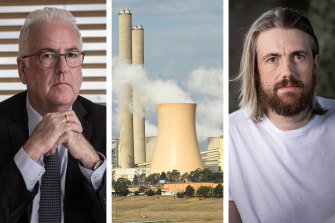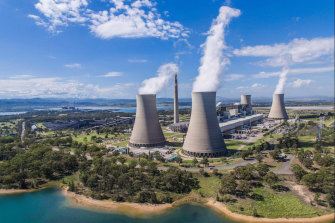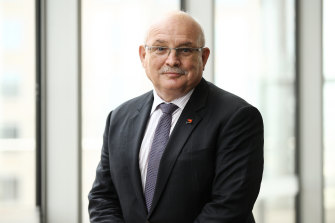On Monday evening, Mike Cannon-Brookes pulled out his phone and took a photo of an idyllic pastoral scene near his home in the New South Wales highlands: a golden-orange sunset, a sparkling river, gum trees silhouetted against the blue sky at dusk. He uploaded it to Twitter, then tapped out a message.
“Stunning country we’re lucky to live in,” he wrote. “Let’s keep it that way.”
Just as the post was filtering through his 105,000 followers, news was beginning to break in the financial community about a bold plan the billionaire investor had quietly set in motion – to swoop onto the share register of AGL, Australia’s largest carbon polluter.

AGL Energy chief executive Graeme Hunt and Atlassian founder Mike Cannon-Brookes, who is seeking to block a demerger of AGL championed by Mr Hunt.Credit:Louise Douvis, Justin McManus, Wolter Peeters
Cannon-Brookes – co-founder of software developer Atlassian, a green energy advocate, and one of Australia’s richest people – had amassed an 11.3 per stake in power giant AGL by relative stealth, instantly making him its biggest shareholder. In his next Twitter post, at 7.01pm, a link to a website he’d created, Keep it Together Australia, explained in detail his reasons why.
AGL, Cannon-Brookes said, was headed down a path that would “entrench” fossil fuels in our economy and was wholly inconsistent with limiting global warming. Through a controversial demerger, AGL’s board is proposing to spin out its carbon-heavy power stations into a standalone company that would continue burning coal until 2045 – more than 20 years away. The demerger is going to a shareholder vote on June 15. And Mike Cannon-Brookes is prepared to do everything he can to stop it.
“This isn’t any old energy company, this is the old energy company – the largest energy company with the most customers,” he tells The Age and the Herald.
“AGL is going to a vote that may change the course of Australia.”
When Cannon-Brookes talks about these threats he perceives, the tone of his voice is serious. But when he begins outlining his vision for AGL’s future – a bigger, better green electricity supplier that fully embraces the clean energy revolution – his excitement, at some points, is impossible to contain.
“Let’s be positive believers!” Cannon-Brookes bursts, his eyes wide and hands upturned.
“This isn’t just philanthropy. This is investment. There’s a huge opportunity in front of this company. And I’m determined to make that happen.”
For its part, AGL’s board is unwavering in its resolve, this week telling shareholders it wholly rejects the premise of Cannon-Brookes’ criticism. Chief executive Graeme Hunt accuses Cannon-Brookes of peddling “false claims” and “rhetoric” without having a proper plan behind it. Cannon-Brookes has signalled he wants AGL to quit coal by 2030 – in line with calls from the United Nations. Hunt says such a timeline is “overly accelerated” and insists the demerger is the company’s best option, as does Grant Samuel, an independent expert that reviewed the proposal.
For AGL’s shareholders, however, the answer is not so immediately obvious.
Investors contacted by The Age and the Herald say Cannon-Brookes’ intervention has added to significant questions about AGL’s role in the clean-energy transition and deepened doubts about the board’s blueprint for the future.
“We’re not sold on the demerger,” says Jamie Hannah, deputy head of investments and Van Eck Australia, one of AGL’s top-10 shareholders. “It’s a big ask what AGL is trying to sell.”
Debby Blakey, chief executive of $64 billion superannuation giant HESTA, which holds AGL shares for members, has warned the fund is unlikely to support the demerger unless it sees a clear strategy to fund renewables and commitments to retire its coal plants “earlier than currently proposed”.
Loading
Small retail investors, too, appear to be responding positively to Cannon-Brookes’ campaign, with hundreds of individuals contacting him via social media to indicate their support.
“I own thousands of AGL shares and will do as @mcannonbrookes suggested,” said one.
“Can’t wait to block the AGL demerger, move off fossil fuels and build a renewable world,” said another. “I’ve got AGL shares and I’m on board to #keepittogether.”
Six weeks from the vote, the considerations facing AGL’s investors have big implications – not only because AGL is the biggest domestic contributor to climate change, but also because its outcome could influence much about the direction of Australia’s electricity sector more broadly, which, similarly, is at an important crossroads.
There is little doubt what the end goal looks like – a green grid, powered by wind and solar, supported by big batteries and pumped hydro. The question is: how fast should we get there?
Discussions like this surrounding the future of coal have driven some of Australia’s deepest political divisions for a decade or more. The difference today, explains Matt Pearce, KPMG’s power and utilities lead, is that the debate is happening in “real time”. After years of extraordinary growth in renewable energy, the market is firmly in the midst of major upheaval, with power prices being pummelled to intraday lows where expensive fossil fuels can simply no longer compete.
“This isn’t something in theory or far away,” says Pearce. “The rubber is hitting the road.”

By this time next year, AGL’s Liddell coal-fired power station will have been switched off for good.
By this time next year, AGL’s Liddell coal-fired power station will have been switched off for good. By as early as 2025, Origin Energy will have closed the nation’s largest coal plant, Eraring, up to seven years earlier than originally planned. Then by 2028, EnergyAustralia’s Yallourn generator in Victoria will have shut – four years early. All the while, renewables are gaining ever-greater market share, reaching a record 30 per cent of the energy mix in the December quarter.
For obvious reasons, many Australians who have long wanted to see the country act more urgently in embracing a greener electricity sector, see this trend as decidedly positive. Speeding up the retreat from coal will go a long way in cleaning up greenhouse gas emissions, as well as reducing the grid’s reliance on ageing, failure-prone and expensive-to-run generators. And because wind and solar are the cheapest sources of electricity, they say, power bills will go down, not up.
Others, however – including Prime Minister Scott Morrison – describe coal as crucial to our electricity grid, and mount the case that moving too quickly to green energy risks causing volatility in the market when the wind isn’t blowing and the sun isn’t shining, which may send prices higher and raise the danger of blackouts.
For a country that still relies on black and brown coal for more than two-thirds of its power consumption, the prospect of getting rid of it almost entirely in just eight years’ time is not a small ask.
Still, experts believe doing so is, in fact, achievable while also keeping the lights on and prices affordable – so long as there is a concerted effort across industry, government and customers to make it happen.
“It requires managing a number of risks,” says KPMG’s Pearce. “A lot of things need to happen all at once.”
One is ensuring there is enough new renewable capacity coming into the system. Renewables are rapidly rising – but against the backdrop of so many coal plants closing in coming years and the looming spike in demand from power-hungry electric vehicles, will it be sufficient? Then there is the need for batteries, gas or pumped hydro, which can supply on-demand electricity when it’s needed most. Another focus must be transmission – poles and wires linking dispersed renewable energy zones to the centres of demand.
“If we can get in front of the transition and put the requisite steps in place, then you won’t get the price shocks … if we are playing catch-up, there could well be,” says Pearce.

AGL chairman Peter Botten.Credit:Bloomberg
The decision to break up AGL into two entities was announced last year after it sank to a $2 billion full-year loss. Chairman Peter Botten declared AGL had reached an “inflection point”, as the influx of rooftop solar and wind and solar farms hammered power generators’ profits and cast a cloud over the company’s outlook.
“There is no doubt that the winds of change in the electricity market have been substantially faster than many people have anticipated,” Botten said at the time. “We are very committed to turning this ship around.”
By forming AGL Australia – a carbon-neutral entity to house the retailing side of the business some cleaner generation assets – the board hopes to appeal to investors that are increasingly distancing themselves from coal on ethical and financial grounds.
At the same time, transferring its power stations into the new Accel Energy would permit a greater focus on the responsible operation of those assets, as well as their transition to lower-carbon energy “hubs”, AGL says. These could eventually include batteries, renewables, and even hydrogen.
One doubt among investors and seized on by Cannon-Brookes is whether Accel can emerge as a viable, standalone public entity, with enough access to capital to meet its huge liabilities including replacement of its assets and remediation costs.
Loading
This week, AGL clinched a deal it hopes will put those concerns “to bed” – a partnership with New York-based Global Infrastructure Partners to buy 49 per cent of Accel’s pipeline of future wind, battery and pumped hydro projects for $94 million. The only condition is that the demerger proceeds.
Hunt says the board had assessed a range of options for the company’s future for more than a year, before landing on the demerger route. He also stresses the importance of ensuring the right “glide path” away from fossil fuels, and the grave risks to the company, its customers and the country of getting it wrong.
“Our plan will work in a measured way,” he says. “What he [Cannon-Brookes] is trying to achieve will put the glide path into a tailspin.”
To Cannon-Brookes, the suggestion of splitting up Australia’s biggest electricity supplier on the eve of extraordinary growth in electricity consumption makes very little sense.
“It boggles my mind,” he says. “People’s homes are going to electrify a lot more, people are going to get electric vehicles, using less petrol and more electricity… So, you know what’s a good business to be in? Selling electricity.”
AGL is no stranger to energy innovation and transition. In fact, AGL is an acronym for its historical name, the Australian Gas Light Company, which lit the first street lamp in Sydney in 1841. “And now they are lighting up 4.5 million people’s houses,” Cannon-Brookes says.
“They didn’t used to be afraid of the future.”
The Business Briefing newsletter delivers major stories, exclusive coverage and expert opinion. Sign up to get it every weekday morning.








